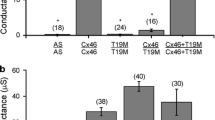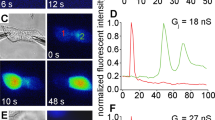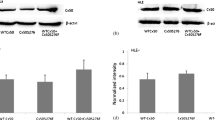Abstract
Connexins form hemichannels at undocked plasma membranes and gap-junction channels (GJCs) at intercellular contacting zones. Under physiological conditions, hemichannels have low open probabilities, but their activation under pathological conditions, such as ischemia, induces and/or accelerates cell death. Connexin 46 (Cx46) is a major connexin of the lens, and mutations of this connexin induce cataracts. Here, we report the effects of linoleic acid (LA) on the electrical properties of Cx46 GJCs and hemichannels expressed in Xenopus laevis oocytes. LA has a biphasic effect, increasing hemichannel current at 0.1 μM and decreasing it at concentrations of 100 μM or higher. The effects of extracellular and microinjected LA conjugated to coenzyme A (LA-CoA) suggest that the current activation site is accessible from the intracellular but not extracellular compartment, whereas the current inhibitory site is either located in a region of the hemichannel pore inaccessible to intracellular LA-CoA, or requires crossing of LA through an organelle membrane. Experiments with other fatty acids demonstrated that the block of hemichannels depends on the presence of a hydrogenated double bond at position 9 and is directly proportional to the number of double bonds. Experiments in paired oocytes expressing Cx46 showed that LA does not affect GJCs. The block by unsaturated fatty acids reported here opens the possibility that increases in the concentration of these lipids in the lens induce cataract formation by blocking Cx46 hemichannels.






Similar content being viewed by others

References
Anel A, Richieri GV, Kleinfeld AM (1993) Membrane partition of fatty acids and inhibition of T cell function. Biochemistry 32:530–536
Bao X, Altenberg GA, Reuss L (2004) Mechanism of regulation of the gap junction protein connexin 43 by protein kinase C-mediated phosphorylation. Am J Physiol Cell Physiol 286:C647–C654
Beahm DL, Hall JE (2004) Opening hemichannels in nonjunctional membrane stimulates gap junction formation. Biophys J 86:781–796
Berthoud VM, Beyer EC (2009) Oxidative stress, lens gap junctions, and cataracts. Antioxid Redox Signal 11:339–353
Besancon E, Guo S, Lok J, Tymianski M, Lo EH (2008) Beyond NMDA and AMPA glutamate receptors: emerging mechanisms for ionic imbalance and cell death in stroke. Trends Pharmacol Sci 29:268–275
Beyer EC, Kistler J, Paul DL, Goodenough DA (1989) Antisera directed against connexin43 peptides react with a 43-kD protein localized to gap junctions in myocardium and other tissues. J Cell Biol 108:595–605
Boger DL, Patterson JE, Guan X, Cravatt BF, Lerner RA, Gilula NB (1998) Chemical requirements for inhibition of gap junction communication by the biologically active lipid oleamide. Proc Natl Acad Sci USA 95:4810–4815
Borenshtein D, Ofri R, Werman M, Stark A, Tritschler HJ, Moeller W, Madar Z (2001) Cataract development in diabetic sand rats treated with alpha-lipoic acid and its gamma-linolenic acid conjugate. Diabetes/Metab Res Rev 17:44–50
Boylan JG, Hamilton JA (1992) Interactions of acyl-coenzyme A with phosphatidylcholine bilayers and serum albumin. Biochemistry 31:557–567
Bruzzone S, Guida L, Zocchi E, Franco L, De Flora A (2001) Connexin 43 hemi channels mediate Ca2+-regulated transmembrane NAD+ fluxes in intact cells. FASEB J 15:10–12
Cascio M (2005) Connexins and their environment: effects of lipids composition on ion channels. Biochim Biophys Acta 1711:142–153
Cherian PP, Siller-Jackson AJ, Gu S, Wang X, Bonewald LF, Sprague E, Jiang JX (2005) Mechanical strain opens connexin 43 hemichannels in osteocytes: a novel mechanism for the release of prostaglandin. Mol Biol Cell 16:3100–3106
Clarke AL, Petrou S, Walsh JV Jr, Singer JJ (2002) Modulation of BK(Ca) channel activity by fatty acids: structural requirements and mechanism of action. Am J Physiol Cell Physiol 283:C1441–C1453
Clarke AL, Petrou S, Walsh JV Jr, Singer JJ (2003) Site of action of fatty acids and other charged lipids on BKCa channels from arterial smooth muscle cells. Am J Physiol Cell Physiol 284:C607–C619
Denson DD, Wang X, Worrell RT, Eaton DC (2000) Effects of fatty acids on BK channels in GH(3) cells. Am J Physiol Cell Physiol 279:C1211–C1219
Ebihara L, Tong JJ, Vertel B, White TW, Chen TL (2011) Properties of connexin 46 hemichannels in dissociated lens fiber cells. Invest Ophthalmol Vis Sci 52:882–889
El-Yassimi A, Hichami A, Besnard P, Khan NA (2008) Linoleic acid induces calcium signaling, Src kinase phosphorylation, and neurotransmitter release in mouse CD36-positive gustatory cells. J Biol Chem 283:12949–12959
Feng DD, Luo Z, Roh SG, Hernandez M, Tawadros N, Keating DJ, Chen C (2006) Reduction in voltage-gated K+ currents in primary cultured rat pancreatic beta-cells by linoleic acids. Endocrinology 147:674–682
Fleschner CR (2006) Connexin 46 and connexin 50 in selenite cataract. Ophthalmic Res 38:24–28
Fraser DA, Thoen J, Rustan AC, Førre O, Kjeldsen-Kragh J (1999) Changes in plasma free fatty acid concentrations in rheumatoid arthritis patients during fasting and their effects upon T-lymphocyte proliferation. Rheumatol Oxf 38:948–952
Glanz D, Lennarz B, Glaesser D (2006) Fatty acid cytotoxicity to organ-cultured bovine lenses. Ophthalmic Res 38:62–65
Gong X, Li E, Klier G, Huang Q, Wu Y, Lei H, Kumar NM, Horwitz J, Gilula NB (1997) Disruption of alpha3 connexin gene leads to proteolysis and cataractogenesis in mice. Cell 91:833–843
Goodenough DA (1979) Lens gap junctions: a structural hypothesis for nonregulated low-resistance intercellular pathways. Invest Ophthalmol Vis Sci 18:1104–1122
Hamilton KL, Syme CA, Devor DC (2003) Molecular localization of the inhibitory arachidonic acid binding site to the pore of hIK1. J Biol Chem 278:16690–16697
Hirschi KK, Minnich BN, Moore LK, Burt JM (1993) Oleic acid differentially affects gap junctionmediated communication in heart and vascular smooth muscle cells. Am J Physiol Cell Physiol 265:C1517–C1526
Hopperstad MG, Srinivas M, Spray DC (2000) Properties of gap junction channels formed by Cx46 alone and in combination with Cx50. Biophys J 79:1954–1966
Iwig M, Glaesser D, Fass U, Struck HG (2004) Fatty acid cytotoxicity to human lens epithelial cells. Exp Eye Res 79:689–704
Jahn CE, Leiss O, von Bergmann K (1983) Lipid composition of human aqueous humor. Ophthalmic Res 15:220–224
Kamp F, Westerhoff HV, Hamilton JA (1992) pH gradients across phospholipid membranes caused by fast flip-flop of un-ionized fatty acids. Proc Natl Acad Sci USA 89:11367–11370
Kangani CO, Kelley DE, DeLany JP (2008) New method for GC/FID and GC-C-IRMS analysis of plasma free fatty acid concentration and isotopic enrichment. J Chromatogr B 873:95–101
Kim MH, Kim MO, Kim YH, Kim JS, Han HJ (2009) Linoleic acid induces mouse embryonic stem cell proliferation via Ca2+/PKC, PI3K/Akt, and MAPKs. Cell Physiol Biochem 23:53–64
Kistler J, Kirkland B, Bullivant S (1985) Identification of a 70, 000-D protein in lens membrane junctional domains. J Cell Biol 101:28–35
Kojima K, Okochi Y, Yagi K (1968) The opacity of the rat lens caused by fatty acid peroxide. Nippon Ganka Gakkai Zasshi 72:1733–1739
Kronfeld PC (1953) Eye changes due to advanced age. Ill Med J 103:104–107
Lo WK, Shaw AP, Takemoto LJ, Grossniklaus HE, Tigges M (1996) Gap junction structures and distribution patterns of immunoreactive connexins 46 and 50 in lens regrowths of Rhesus monkeys. Exp Eye Res 62:171–180
Locke D, Harris AL (2009) Connexin channels and phospholipids: association and modulation. BMC Biol 17:7–52
Lu M, Taylor A, Chylack LT Jr, Rogers G, Hankinson SE, Willett WC, Jacques PF (2005) Dietary fat intake and early age-related lens opacities. Am J Clin Nutr 81:773–779
Mathias RT, Rae JL, Baldo GJ (1997) Physiological properties of the normal lens. Physiol Rev 77:21–50
Matta JA, Miyaresm RL, Ahern GP (2007) TRPV1 is a novel target for omega-3 polyunsaturated fatty acids. J Physiol 578:397–411
Nguyen N, Glanz D, Glaesser D (2000) Fatty acid cytotoxicity to bovine lens epithelial cells: investigations on cell viability, ecto-ATPase, Na(+), K(+)-ATPase and intracellular sodium concentrations. Exp Eye Res 71:405–413
Nojima H, Ohba Y, Kita Y (2007) Oleamide derivatives are prototypical anti-metastasis drugs that act by inhibiting Connexin 26. Curr Drug Saf 2:204–211
Oliveira VH, Nascimento KS, Freire MM, Moreira OC, Scofano HM, Barrabin H, Mignaco JA (2008) Mechanism of modulation of the plasma membrane Ca(2+)-ATPase by arachidonic acid. Prostaglandins Other Lipid Mediat 87:47–53
Pal JD, Berthoud VM, Beyer EC, Mackay D, Shiels A, Ebihara L (1999) Molecular mechanism underlying a Cx50-linked congenital cataract. Am J Physiol Cell Physiol 276:C1443–C1446
Pal JD, Liu X, Mackay D, Shiels A, Berthoud VM, Beyer EC, Ebihara L (2000) Connexin46 mutations linked to congenital cataract show loss of gap junction channel function. Am J Physiol Cell Physiol 279:C596–C602
Paul DL, Ebihara L, Takemoto LJ, Swenson KI, Goodenough DA (1991) Connexin46, a novel lens gap junction protein, induces voltage-gated currents in nonjunctional plasma membrane of Xenopus oocytes. J Cell Biol 115:1077–1089
Retamal MA, Froger N, Palacios-Prado N, Ezan P, Sáez PJ, Sáez JC, Giaume C (2007) Cx43 hemichannels and gap junction channels in astrocytes are regulated oppositely by proinflammatory cytokines released from activated microglia. J Neurosci 27:13781–13792
Retamal MA, Yin S, Altenberg GA, Reuss L (2009) Modulation of Cx46 hemichannels by nitric oxide. Am J Physiol Cell Physiol 296:C1356–C1363
Retamal MA, Yin S, Altenberg GA, Reuss L (2010) Voltage-dependent facilitation of Cx46 hemichannels. Am J Physiol Cell Physiol 298:C132–C139
Roberts-Crowley ML, Rittenhouse AR (2009) Arachidonic acid inhibition of L-type calcium (CaV1.3b) channels varies with accessory CaVbeta subunits. J Gen Physiol 133:387–403
Sáez JC, Schalper KA, Retamal MA, Orellana JA, Shoji KF, Bennett MV (2010) Cell membrane permeabilization via connexin hemichannels in living and dying cells. Exp Cell Res 316:2377–2389
Schalper KA, Palacios-Prado N, Retamal MA, Shoji KF, Martínez AD, Sáez JC (2008) Connexin hemichannel composition determines the FGF-1-induced membrane permeability and free [Ca2+]i responses. Mol Biol Cell 19:3501–3513
Schmitz G, Ecker J (2008) The opposing effects of n-3 and n-6 fatty acids. Prog Lipid Res 47:147–155
Steinberg G, Slaton WH Jr, Howton DR, Mead JF (1956) Metabolism of essential fatty acids. IV. Incorporation of linoleate into arachidonic acid. J Biol Chem 220:257–264
Stout CE, Costantin JL, Naus CC, Charles AC (2002) Intercellular calcium signaling in astrocytes via ATP release through connexin hemichannels. J Biol Chem 277:10482–10488
Stridh MH, Tranberg M, Weber SG, Blomstrand F, Sandberg M (2008) Stimulated efflux of amino acids and glutathione from cultured hippocampal slices by omission of extracellular calcium: likely involvement of connexin hemichannels. J Biol Chem 283:10347–10356
Tan JS, Wang JJ, Mitchell P (2008) Influence of diabetes and cardiovascular disease on the long-term incidence of cataract: the Blue Mountains eye study. Ophthalmic Epidemiol 15:317–327
Trimborn M, Iwig M, Glanz D, Gruner M, Glaesser D (2000) Linoleic acid cytotoxicity to bovine lens epithelial cells: influence of albumin on linoleic acid uptake and cytotoxicity. Ophtalmic Res 32:87–93
Ye ZC, Wyeth MS, Baltan-Tekkok S, Ransom BR (2003) Functional hemichannels in astrocytes: a novel mechanism of glutamate release. J Neurosci 23:3588–3596
Acknowledgments
This work was supported by the National Institutes of Health grants GM068586, GM79629, and R01GM079629-03S1; Texas Advanced Research Program grant 010674-0046-2007; Fondecyt de Iniciación 11080061; and Proyecto Interno Universidad del Desarrollo 23.400.012.
Author information
Authors and Affiliations
Corresponding author
Rights and permissions
About this article
Cite this article
Retamal, M.A., Evangelista-Martínez, F., León-Paravic, C.G. et al. Biphasic effect of linoleic acid on connexin 46 hemichannels. Pflugers Arch - Eur J Physiol 461, 635–643 (2011). https://doi.org/10.1007/s00424-011-0936-3
Received:
Revised:
Accepted:
Published:
Issue Date:
DOI: https://doi.org/10.1007/s00424-011-0936-3



